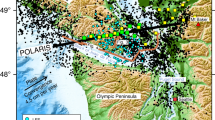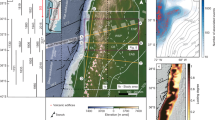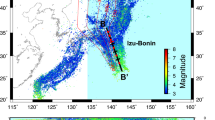Abstract
Analysis of deep subduction-zone earthquakes, those at depths greater than 60 km, reveals the physical and chemical properties of a descending oceanic lithosphere at mantle depths. Over the past five decades, it has been observed that a large fraction of deep earthquakes has non-double-couple (non-DC) seismic radiation patterns. In contrast, shallow earthquakes tend to have DC radiation patterns due to mechanisms of shear faulting. These observations have been used to argue that deep earthquakes rupture differently from shallow earthquakes. Here we show that the observed global distribution of non-DC deep earthquakes could be caused by shear faulting mechanisms, but in a highly anisotropic laminated rock fabric that surrounds the deep earthquakes within subducted slabs. For intermediate-depth earthquakes (~60–300 km), we found a large shear-wave anisotropy of ~25%, possibly caused by laminated fabric or aligned melt pockets oriented parallel to the slab interface, which provides new supporting evidence for the metamorphic dehydration reactions in slabs. However, at deep-focus depths (>300 km), the putative metastable phase-change mechanism alone cannot explain the seismic anisotropy. Instead, our results and those from recent experiments suggest materials such as magnesite, or perhaps carbonatite melt, may play a role in generating deep-focus earthquakes.
This is a preview of subscription content, access via your institution
Access options
Access Nature and 54 other Nature Portfolio journals
Get Nature+, our best-value online-access subscription
$29.99 / 30 days
cancel any time
Subscribe to this journal
Receive 12 print issues and online access
$259.00 per year
only $21.58 per issue
Buy this article
- Purchase on Springer Link
- Instant access to full article PDF
Prices may be subject to local taxes which are calculated during checkout




Similar content being viewed by others
References
Hacker, B. R., Peacock, S. M., Abers, G. A. & Holloway, S.D. Subduction factory. 2. Are intermediate-depth earthquakes in subducting slabs linked to metamorphic dehydration reactions?J. Geophys. Res. Sol. Earth 108, 2029 (2003).
Frohlich, C. Deep Earthquakes (Cambridge Univ. Press, Cambridge, 2006).
Houston, H. in Treatise on Geophysics 2nd edn, Vol. 4 (ed. Schubert, G.) 329–354 (Elsevier, Amsterdam, 2015).
Julian, B. R., Miller, A. D. & Foulger, G. R. Non-double-couple earthquakes 1. Theory. Rev. Geophys. 36, 525–549 (1998).
Knopoff, L. & Randall, M. J. Compensated linear–vector dipole—a possible mechanism for deep earthquakes. J. Geophys Res. 75, 4957-& (1970).
Kuge, K. & Kawakatsu, H. Significance of nondouble couple components of deep and intermediate-depth earthquakes: implications from moment tensor inversions of long-period seismic waves. Phys. Earth Planet. Inter. 75, 243–266 (1993).
Richardson, E. & Jordan, T. H. Low-frequency properties of intermediate-focus earthquakes. Bull. Seismol. Soc. Am. 92, 2434–2448 (2002).
Kuge, K. & Lay, T. Data-dependent non-double-couple components of shallow earthquake source mechanisms—effects of wave-form inversion instability. Geophys Res Lett. 21, 9–12 (1994).
Frohlich, C. Earthquakes with non-double-couple mechanisms. Science 264, 804–809 (1994).
Evison, F. F. Earthquakes and faults. Bull. Seismol. Soc. Am. 53, 873–891 (1963).
Kirby, S. H. Localized polymorphic phase transformations in high-pressure faults and applications to the physical mechanism of deep earthquakes. J. Geophys. Res. Sol. Earth 92, 13789–13800 (1987).
Green, H. W. Shearing instabilities accompanying high-pressure phase transformations and the mechanics of deep earthquakes. Proc. Natl Acad. Sci. USA 104, 9133–9138 (2007).
Schubnel, A. et al. Deep-focus earthquake analogs recorded at high pressure and temperature in the laboratory. Science 341, 1377–1380 (2013).
Kawasaki, I. & Tanimoto, T. Radiation patterns of body waves due to the seismic dislocation occurring in an anisotropic source medium. Bull. Seismol. Soc. Am. 71, 37–50 (1981).
Vavrycuk, V. Inversion for anisotropy from non-double-couple components of moment tensors. J. Geophys. Res. Sol. Earth 109, B07306 (2004).
Thomsen, L. Weak elastic anisotropy. Geophysics 51, 1954–1966 (1986).
Dziewonski, A. M., Chou, T. A. & Woodhouse, J. H. Determination of earthquake source parameters from waveform data for studies of global and regional seismicity. J. Geophys. Res. 86, 2825–2852 (1981).
Aki, K. & Richards, P. G. Quantitative Seismology (University Science Books, Herndon, 2002).
Leonard, M. Earthquake fault scaling: self-consistent relating of rupture length, width, average displacement, and moment release. Bull. Seismol. Soc. Am. 100, 1971–1988 (2010).
Frohlich, C. & Davis, S. D. How well constrained are well-constrained T, B, and P axes in moment tensor catalogs? J. Geophys. Res. Sol. Earth 104, 4901–4910 (1999).
Gudmundsson, Ó.& Sambridge, M. A regionalized upper mantle RUM seismic model. J. Geophys. Res. Sol. Earth 103, 7121–7136 (1998).
Nowacki, A., Kendall, J. M., Wookey, J. & Pemberton, A. Mid-mantle anisotropy in subduction zones and deep water transport. Geochem. Geophys. Geosyst. 16, 764–784 (2015).
Vinnik, L. P. & Kind, R. Ellipticity of teleseismic S-particle motion. Geophys. J. Int. 113, 165–174 (1993).
Lynner, C. & Long, M. D. Sub-slab anisotropy beneath the Sumatra and circum-Pacific subduction zones from source-side shear wave splitting observations. Geochem. Geophys. Geosyst. 15, 2262–2281 (2014).
Long, M. D. Constraints on subduction geodynamics from seismic anisotropy. Rev. Geophys. 51, 76–112 (2013).
Chang, S.-J., Ferreira, A. M. G., Ritsema, J., van Heijst, H. J. & Woodhouse, J. H. Joint inversion for global isotropic and radially anisotropic mantle structure including crustal thickness perturbations. J. Geophys. Res. Sol. Earth 120, 4278–4300 (2015).
Yuan, K. & Beghein, C. Seismic anisotropy changes across upper mantle phase transitions. Earth Planet. Sci. Lett. 374, 132–144 (2013).
Syracuse, E. M., van Keken, P. E. & Abers, G. A. The global range of subduction zone thermal models. Phys. Earth Planet. Inter. 183, 73–90 (2010).
Karato, S., Jung, H., Katayama, I. & Skemer, P. Geodynamic significance of seismic anisotropy of the upper mantle: new insights from laboratory studies. Annu. Rev. Earth Planet. Sci. 36, 59–95, (2008).
Jung, H., Mo, W. & Green, H. W. Upper mantle seismic anisotropy resulting from pressure-induced slip transition in olivine. Nat. Geosci. 2, 73–77 (2009).
Jung, H., Park, M., Jung, S. & Lee, J. Lattice preferred orientation, water content, and seismic anisotropy of orthopyroxene. J. Earth Sci. 21, 555–568 (2010).
Mainprice, D. & Ildefonse, B. in Subduction Zone Geodynamics (eds Lallemand, S. & Funiciello, F.) 63–84 (Springer, Berlin, 2009).
Yang, J., Mao, Z., Lin, J. F. & Prakapenka, V. B. Single-crystal elasticity of the deep-mantle magnesite at high pressure and temperature. Earth Planet. Sci. Lett. 392, 292–299 (2014).
Brownlee, S. J., Hacker, B. R., Harlow, G. E. & Seward, G. Seismic signatures of a hydrated mantle wedge from antigorite crystal-preferred orientation (CPO). Earth Planet. Sci. Lett. 375, 395–407 (2013).
Raleigh, C. B. & Paterson, M. S. Experimental deformation of serpentinite and its tectonic implications. J. Geophys. Res. 70, 3965–3985 (1965).
Green, H. W., Chen, W. P. & Brudzinski, M. R. Seismic evidence of negligible water carried below 400-km depth in subducting lithosphere. Nature 467, 828–831 (2010).
Bina, C. R. & Wood, B. J. Olivine–spinel transitions—experimental and thermodynamic constraints and implications for the nature of the 400-km seismic discontinuity. J. Geophys. Res. Sol. Earth 92, 4853–4866 (1987).
Stagno, V. et al. The stability of magnesite in the transition zone and the lower mantle as function of oxygen fugacity. Geophys. Res. Lett. 38, L19309 (2011).
Holyoke, C. W., Kronenberg, A. K., Newman, J. & Ulrich, C. Rheology of magnesite. J. Geophys. Res. Sol. Earth 119, 6534–6557 (2014).
Thomson, A. R., Walter, M. J., Kohn, S. C. & Brooker, R. A. Slab melting as a barrier to deep carbon subduction. Nature 529, 76–79 (2016).
Fukao, Y. & Obayashi, M. Subducted slabs stagnant above, penetrating through, and trapped below the 660 km discontinuity. J. Geophys. Res. Sol. Earth 118, 5920–5938 (2013).
Weinberg, R. F., Veveakis, E. & Regenauer-Lieb, K. Compaction-driven melt segregation in migmatites. Geology 43, 471–474 (2015).
Veveakis, E., Regenauer-Lieb, K. & Weinberg, R. F. Ductile compaction of partially molten rocks: the effect of non-linear viscous rheology on instability and segregation. Geophys. J. Int. 200, 519–523 (2015).
Efron, B. & Tibshirani, R. J. An Introduction to the Bootstrap (Taylor & Francis, New York, 1994).
Dziewonski, A. M. & Anderson, D. L. Preliminary reference Earth model. Phys. Earth Planet. Inter. 25, 297–356 (1981).
Zhou, H.-W. Mapping of P-wave slab anomalies beneath the Tonga, Kermadec and New Hebrides arcs. Phys. Earth Planet. Inter. 61, 199–229 (1990).
Zhao, D. P. Global tomographic images of mantle plumes and subducting slabs: insight into deep Earth dynamics. Phys. Earth Planet. Inter. 146, 3–34 (2004).
Fang, X., Fehler, M., Chen, T., Burns, D. & Zhu, Z. Sensitivity analysis of fracture scattering. Geophysics 78, T1–T10 (2012).
Cheng, C. H. Crack models for a transversely isotropic medium. J. Geophys. Res. Solid Earth 98, 675–684 (1993).
Thomsen, L. Elastic anisotropy due to aligned cracks in porous rock. Geophys. Prospect. 43, 805–829 (1995).
Acknowledgements
We thank T. Lay for his suggestion to investigate the influence of the slab velocity anomaly on the radiation pattern. We also thank K. Burke, H. Zhou and J. Suppe for discussions, manuscript reading and comments. We appreciate the CMT data without which this work is impossible. We appreciate J. Wu for providing help on the tomography models. This work is supported by NSF EAR-1621878.
Author information
Authors and Affiliations
Contributions
Y.Z. started this research by analysing the CMT database to investigate anisotropy for global slabs using non-DC deep earthquakes. He also contributed to all aspects of the research, including manuscript writing. L.T. contributed to the analysis of anisotropy and earthquake radiation patterns. J.L. did the inversion of anisotropy and analysed and ruled out the effect of slab heterogeneity as a major factor in producing non-DC radiation. X.F. did the 3D elastic anisotropic FD modelling for the slab heterogeneity influence on earthquake radiation patterns. T.L. contributed to the petrological causes of the anisotropy.
Corresponding author
Ethics declarations
Competing interests
The authors declare no competing interests.
Additional information
Publisher’s note: Springer Nature remains neutral with regard to jurisdictional claims in published maps and institutional affiliations.
Supplementary information
Supplementary Information
Supplementary Figures and Tables
Rights and permissions
About this article
Cite this article
Li, J., Zheng, Y., Thomsen, L. et al. Deep earthquakes in subducting slabs hosted in highly anisotropic rock fabric. Nature Geosci 11, 696–700 (2018). https://doi.org/10.1038/s41561-018-0188-3
Received:
Accepted:
Published:
Issue Date:
DOI: https://doi.org/10.1038/s41561-018-0188-3
This article is cited by
-
Earthquake focal mechanisms with distributed acoustic sensing
Nature Communications (2023)
-
Similar seismic moment release process for shallow and deep earthquakes
Nature Geoscience (2023)
-
The Variability of Earthquake Parameters with the Depth: Evidences of Difference of Mechanisms of Generation of the Shallow, Intermediate-Depth, and the Deep Earthquakes
Pure and Applied Geophysics (2022)
-
Towards a regional, automated full moment tensor inversion for medium to large magnitude events in the Iranian plateau
Journal of Seismology (2021)
-
Geodynamic subduction models constrained by deep earthquakes beneath the Japan Sea and eastern China
Scientific Reports (2020)



